Last week I had a look at tram stops that are triply inaccessible – where the only way to leave the tram stop is a set of stairs. But there is another feature of tram stop platforms that render them inaccessible – inconsistent platform heights.
A tale of legacy platform stops
Melbourne has a number of ‘legacy’ platform stops that predate the rollout of low-floor trams, and so don’t provide a level boarding experience – but to the average passenger, they look no different to an accessible tram stop.
One of these trams stops was in the news back in 2016, after a man who uses a mobility scooter said the tram driver refused to deploy a ramp so he could board the tram.
A Melbourne man with MS who uses a mobility scooter says a tram driver repeatedly refused to deploy a ramp to help him board so he could get to hospital for treatment, and he had to be lifted on by passengers.
Sean Cox said he tried to get onto the 19 tram at the intersection of Royal Parade and Brunswick Road in Brunswick on three separate days this week, but each time the driver did not allow him to use the wheelchair ramp.
“Even though they’re all kitted out, they’ve all got ramps, [the drivers] are saying ‘No, the manager says we can’t put the ramp down’,” he told 774 ABC Melbourne
Mr Cox said he needed the ramp to help get his scooter over a two-inch step.
A spokeswoman for Yarra Trams told the ABC the ramps were only for emergency situations and not to be used to help passengers board the trams at old stops.
The tram stop at Royal Parade and Brunswick Road on route 19 in Brunswick looks like an accessible platform stop.
But the ‘platform’ is actually just an asphalt footpath on the traffic island, with a kerb separating it from the tram tracks.
Similar ‘platform’ tram stops exist elsewhere on the Melbourne tram network, like this one on route 57 at Abbotsford Street and Flemington Road.
This one in the middle of Kings Way on route 58.
All of these tram stops are accessed via traffic lights, unlike the stops only accessible via stairs, as I’ve mentioned before.
Towards standards
Melbourne entered the low floor tram era with the C class ‘Citadis’ trams delivered in 2001, followed by D class ‘Combino’ trams from 2002.
With the first accessible platform stop opened on Collins Street in October 2001.
However the Disability Standards for Accessible Public Transport only specify the size of boarding gaps.
8.2 – When boarding devices must be provided.
(1) A manual or power assisted boarding device must be available at any accessible entrance to a conveyance that has:
(a) a vertical rise or gap exceeding 12 mm (AS/NZS3856.1 (1998) Clause 2.1.7 (f)); or
(b) a horizontal gap exceeding 40 mm (AS/NZS3856.1 (1998) Clause 2.1.8 (g)).
Which presented difficulties when determining a standard for tram floor and platform heights, given we purchsed off-the-shelf low-floor trams from Europe.
Where a platform stop exists, most passengers with a mobility impairment will be able to board a low floor tram safely and independently unless there is a boarding gap acting as a barrier to access. Victoria’s objective is to provide independent access which is best achieved with low floor trams and level access stops.
The current boarding gap of 12mm (vertical) and 40mm (horizontal) specified in DSAPT is based on an Australian Standard for hoists and ramps used for road transport including buses and taxis. However, there is no specific standard for trams and European standards have different vertical and horizontal gap requirements for deployment of ramps. Victoria recommends that the current standard in 8.2 be reviewed with the aim of developing a specific standard for trams.
Hence gaps like this one between a D1 class Combino tram and the platform stop at Melbourne University.
And this C2 class Citadis tram on Bourke Street.
Rubber gap filling panels were fitted to C2 class trams in an attempt to make boarding easier.
But gap fillers fitted to D1 class trams caused another problem – the trams would now hit the platform, so a 30 km/h speed restriction was imposed!
Made in Melbourne for Melbourne?
The new E class trams were the first low-floor trams built in Melbourne, for Melbourne, so one might think they’d be designed to fit our existing platform stops.
Disability rules bypassed in low-floor tram rush
Josh Gordon
September 12, 2011The Department of Transport knowingly breached federal anti-discrimination laws by ignoring wheelchair accessibility rules on trams.
A tender assessment from September last year for 50 new “low-floor trams” reveals that the department decided a Disability Discrimination Act requirement for a step height between platforms and trams of no more than 12 millimetres was too onerous, instead asking for a cheaper 50 millimetre option, which is the European standard.
“It was determined that the 12mm option was not feasible and should not be actively pursued”, the briefing to Martin Pakula, transport minister in the former Labor government, says.
The documents, obtained under freedom of information laws by Greens MP Greg Barber, warn that no tenders had developed a “workable system” to meet the requirement, saying the impact on delivery times and maintenance was too great.
The result vertical gap doesn’t look all that big.
But at other tram stops, there is a big horizontal gap.
And to reduce the gaps, a convoluted ramp had to be created inside each doorway of the tram, creating a slip hazzard.
But still not good enough
In 2014 Yarra Trams started ripping up a number of existing platform stops.
Closing them to passengers.
While they pulled up the bluestone paving.
Then put it all back into place.
The only difference – the platform edge was 30 mm higher.
Yarra Trams detailed the reason for the work in their Q3 2014 Accessibility Update.
Yarra Trams continues to work closely with Public Transport Victoria to enhance the accessibility of Melbourne’s tram network. As part of this commitment, resurfacing works are scheduled to be completed at a number of existing level access stops on the network this year.
The works involve raising existing level access stops approximately 30mm to improve accessibility for all passengers, particularly those using a mobility aid.
Stops that have benefitted from this work so far include stops in the sporting precinct near the MCG, AAMI Park, Hisense Arena and Rod Laver Arena, Melbourne University, Alfred Hospital and Bourke Street Mall.
These changes to the surface of the level access stops are designed to ensure a standard height for level access tram stops in Melbourne.
And provided a full list in their 2015–18 Accessibility Action Plan.
In 2014, Yarra Trams completed work to retrofit several accessible tram stops that were built to old standards. The tram stops were raised from 260mm to 290mm at the following locations:
· Melbourne University
· Flinders Street at Spencer Street
· Flinders Street at King Street
· Flinders Street at Market Street
· The Alfred Hospital
· Spencer Street at Collins Street (Southern Cross Station)
· Bridge Road at Hawthorn Bridge
· Collins Street at Swanston Street (Town Hall)
· MCG / Hisense Arena
· Rod Laver Arena
· AAMI Park
· Batman Avenue at William Barak Bridge
· Bourke Street at Elizabeth Street
· Bourke Street at Swanston Street
But even this wasn’t good enough – in 2016 Yarra Trams trialled the use of ramps at platform stops.
Access problems at super stops prompt trial of wheelchair ramps on new trams
Adam Carey
May 3, 2016Boarding ramps will be trialled on Melbourne’s new E-Class trams to bridge an excessive step height at super stop platforms that prevents some wheelchair passengers safely entering the tram.
The height difference between platforms and tram floors is big enough to have put the Victorian government in breach of national disability discrimination laws, a problem that was identified before E-Class trams were first ordered in 2010, but has never been fixed.
Instead this year, under a trial proposed by Yarra Trams, manual ramps will be deployed by tram drivers at platform stops along route 96 between East Brunswick and St Kilda Beach, one of Melbourne’s busiest tram routes.
Ray Jordan of disability access group All Aboard said the group welcomed all efforts to improve access to trams, given some super stops still leave a problem gap.
“There are a lot of people who find themselves still unable to use the [E-Class] trams because their particular wheelchair won’t get up that step,” Mr Jordan said. “The step could be 30 to 60 millimetres, it varies. Some wheelchairs can handle that, many can’t,” he said.
But they’re still building non-compliant ‘platform’ stops
As part of the rebuild of the tram tracks along Elizabeth Street in 2012, a new ‘platform’ stop was created at La Trobe Street.
But it wasn’t actually accessible – but just a section of tram tracks sunken beneath the level of the neighbouring road, waiting for a real platform stop to be built.
Something that wasn’t provided until 2013.
And another screw up occurred in 2020, following the rebuilding of the tram tracks through Royal Park on route 58.
The ‘platform’ was built too far from the tracks, and so forced to close for repair work.
Route 58 – Stop 23 Royal Park closure
Wednesday 9 December to Tuesday 22 December 2020Date and time
Wednesday 9 December until further notice.Tram stop changes
Stop 23 Royal Park towards West Coburg is closed. Passengers can connect to trams towards West Coburg from Stop 19 Royal Children’s Hospital (up to 350m / 4 minute walk) or Stop 24 Elliott Avenue (up to 400m / 5 minute walk).
We’ve got a long way still to go
Postscript
Thankfully the tram stop on route 19 Sydney and Brunswick Road was upgraded in 2018 – and it’s now a real platform stop.
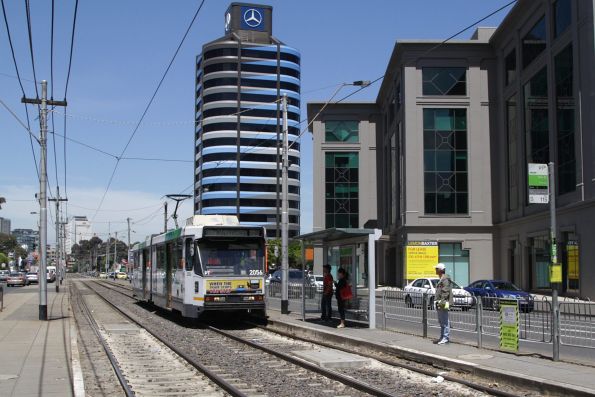
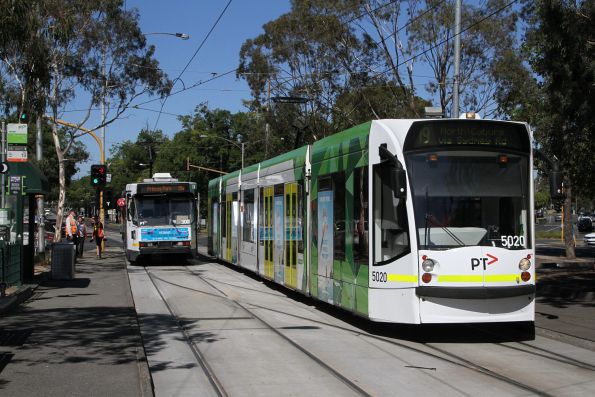
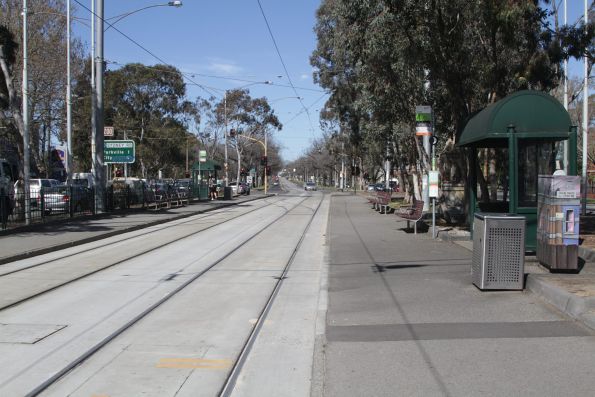

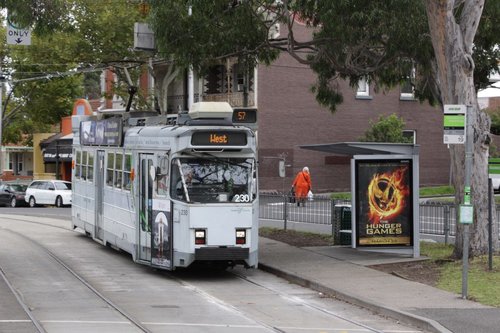
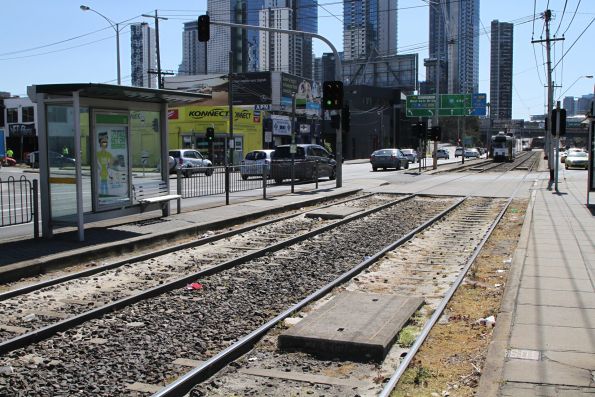
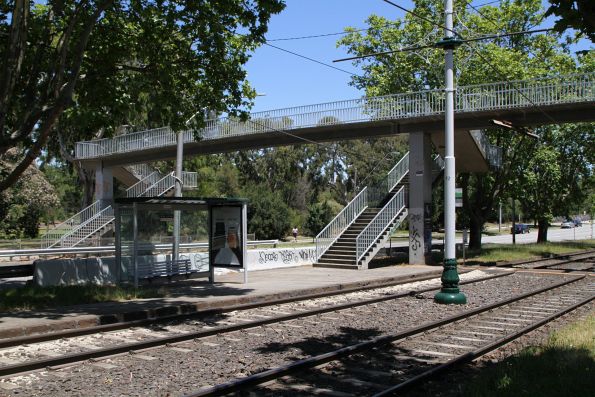
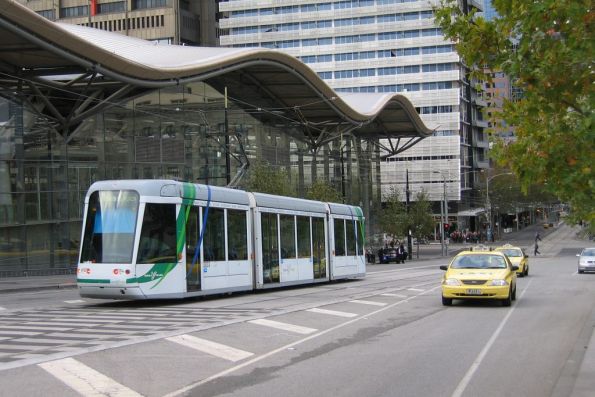
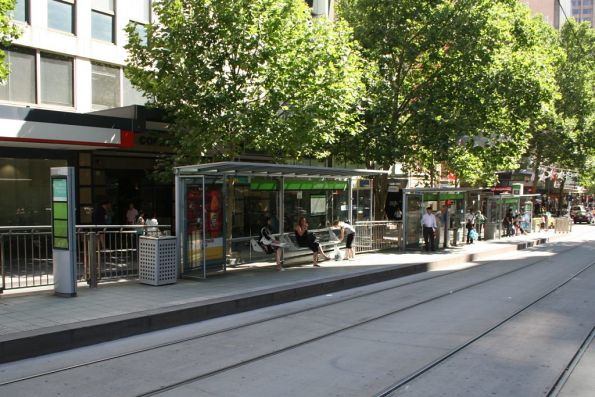
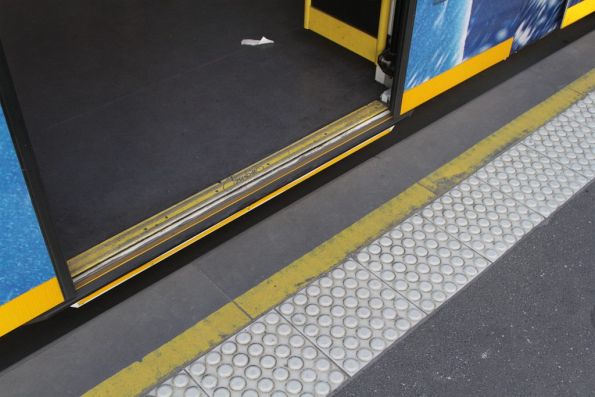
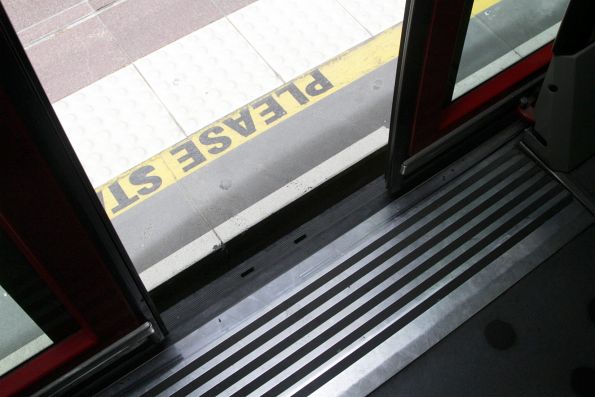
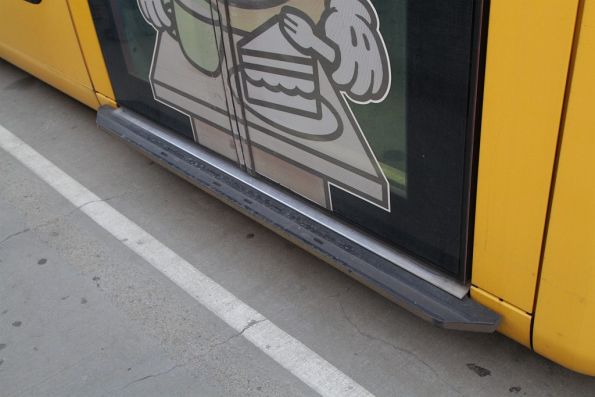
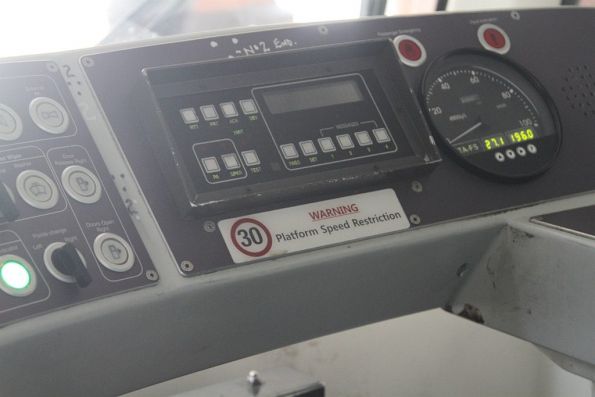
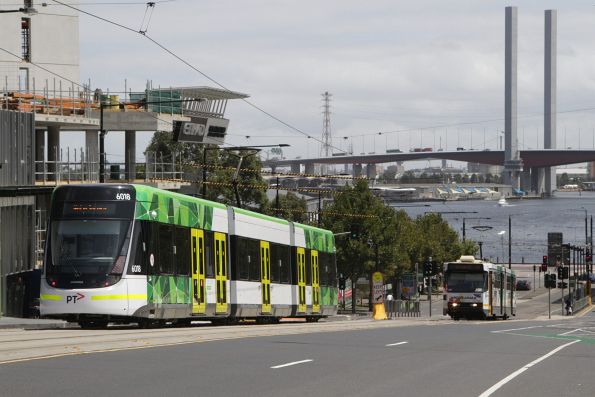
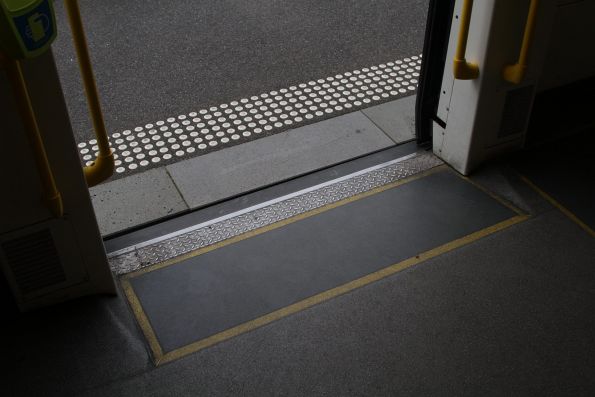
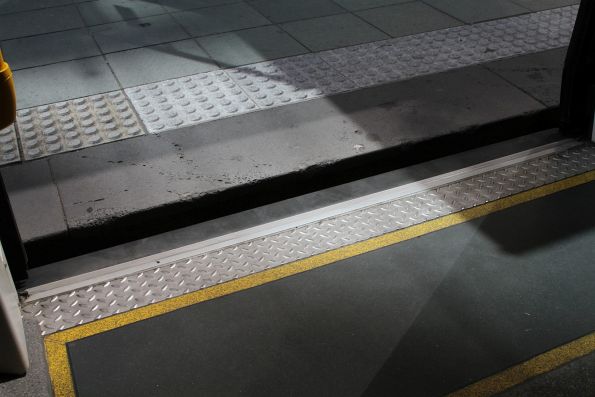
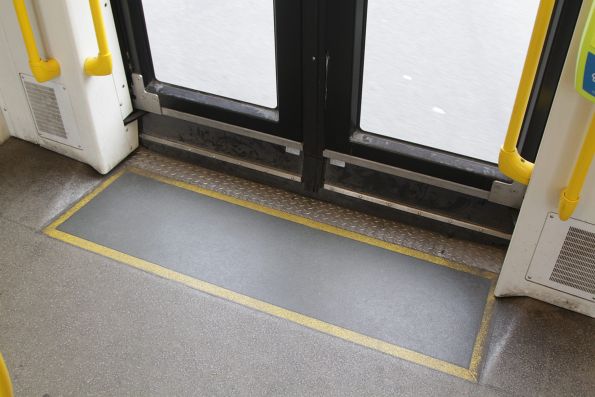
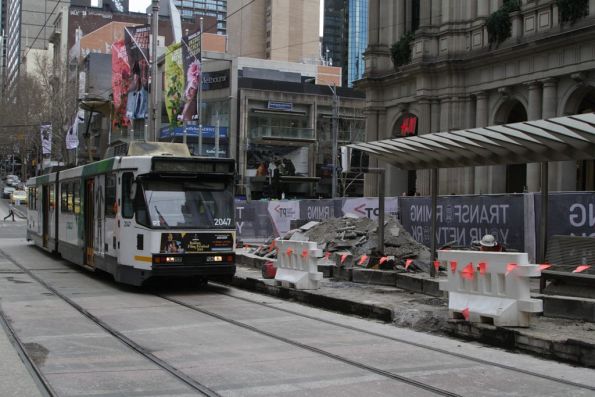
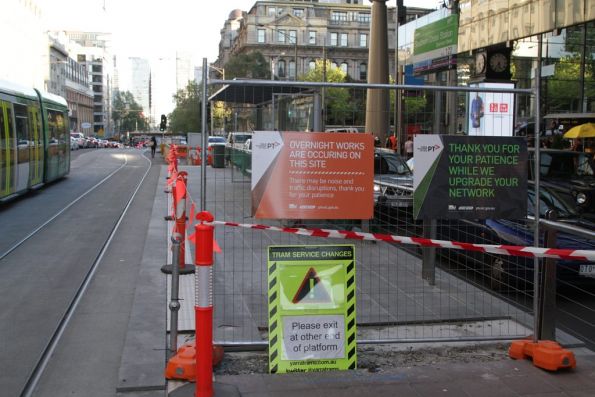
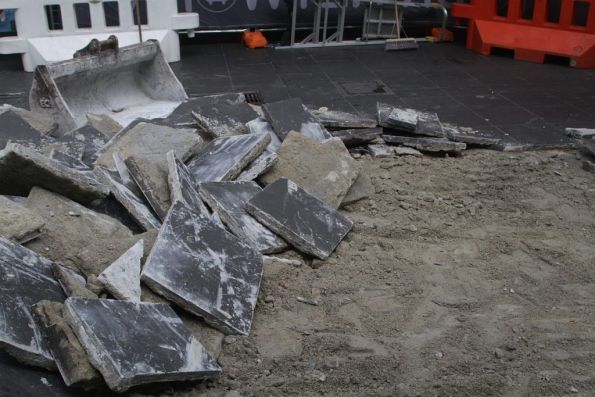
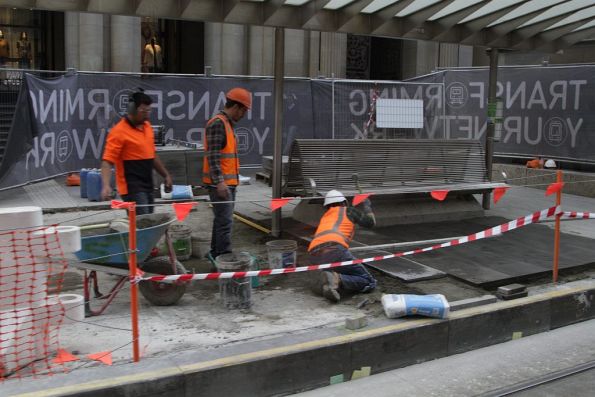
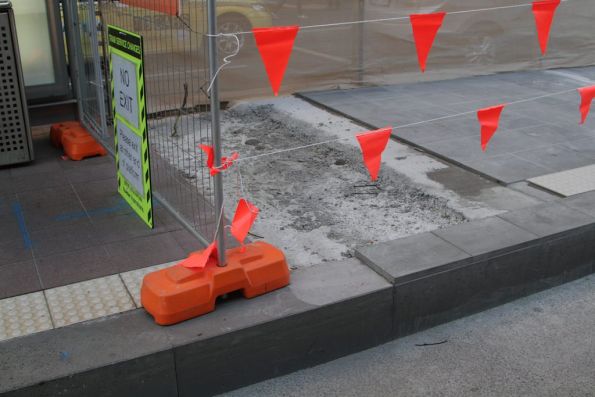
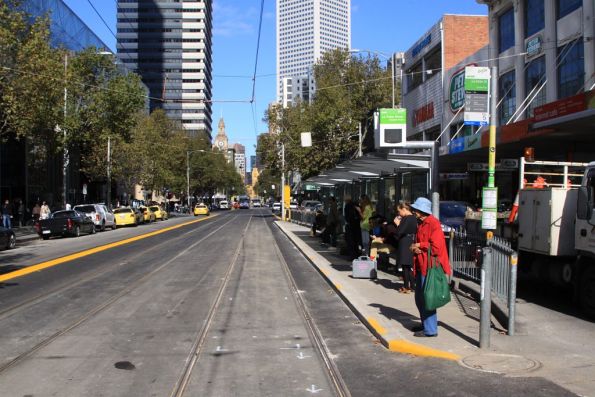
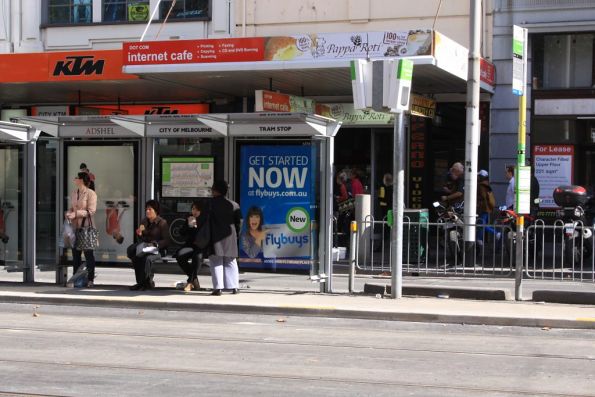
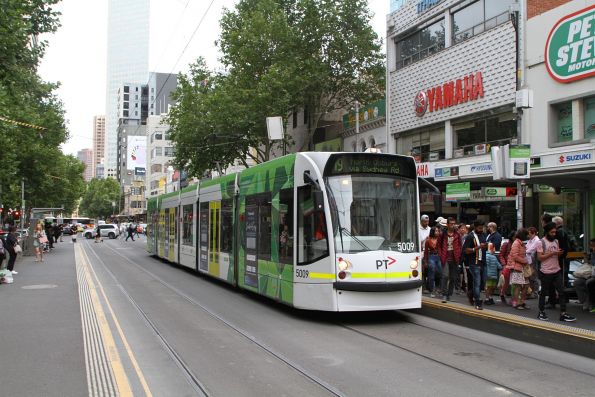
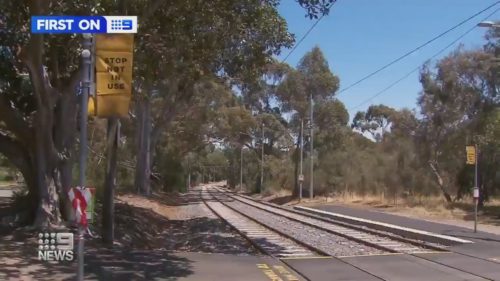
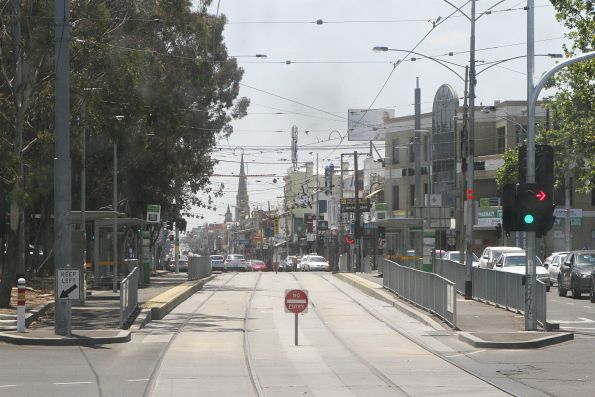

The glacially slow rollout of platform stops in Melbourne is something ofa disgrace. I do wonder what combination of factors affect this
– VicRoads/Local council not wanting to give up road/parking spaces
– Funding from State Government
– Yarra Trams internal processes
– Local resident opposition
– Network disruption
I’d have thought that doing a major tram stop blitz, similar to Level Crossing Removal Program, could be a great post-COVID recovery tool, with local economy stimulation and small contractor for 1/100th the price of a level crossing remval
VicRoads is more concerned about motor vehicle traffic.
From here:
https://www.vicroads.vic.gov.au/-/media/files/technical-documents-new/traffic-engineering-manual-v2/tem-vol-2-part-212–as174212-bus-transit-tram-and-truck-lanes.ashx
The speed limit through platform stops specified in drivers’ training manuals is actually 10 km/h, so the 30 km/h label on the console is logically conflicting.
My photo was from 2017 – maybe the speed was dropped since then?
With 1100+ team stops still to be made accessible by 2032 I can’t possibly see how this will be achieved.
Even if the Bridge Road/Victoria St type of stop is rolled out to the rest this still involves shutting major roads for up to a week.
Sounds like the old proverb about planting a tree – “The best time to plant a tree was years ago. The second best time is now”.
I wonder if there are width issues with putting platform stops within the existing median strip in Kingsway?
Yarra Trams has a list of “stations with restricted paths of travel” in their report on temporary exemptions to the Disability Standards for Accessible Public Transport 2002.
https://ara.net.au/sites/default/files/u647/Yarra%20Trams%20Temporary%20Exemptions%20Report%202018%20FINAL.PDF
Minimum unobstructed width is 1,200mm minimum unobstructed, with 1,000mm permitted due to structural and technical constraints, and 850mm minimum unobstructed width permitted when passing an obstruction limited to less than 800mm in length.
The Kings Way tram stops appear as “Level access stops that have restricted width along the length of the stop” and “Safety Zone stops that have restricted width along the length of the stop”
Sturt St looks potentially achievable, if the Toorak-bound stop is moved to the departure side (although the tram curve creates a bit of a pedestrian access issue). York St Toorak-bound looks achievable, West Coburg-bound looks far move difficult. Park St/Kingsway appears to have been deleted as a stop.
I believe the Park Street/Kings Way tram stop was closed in 2018 when the new platform stop was opened on Park Street as part of the Metro Tunnel works for Domain Interchange.
Any ideas on if it will reopen once the Metro Tunnel works are completed?
The new platform stop is located much closer to Domain Interchange than the old stop on the corner which makes it kind of redundant once the interchange reopens. The current platform stop is very frustrating for those west of Kings Way as frequently the trams are held at the lights on the corner for a very long light cycle but passengers are unable to get on.
I suspect the tram stop is gone for good, like like many others across the network when platform stops were installed.
https://wongm.com/2013/11/elizabeth-street-tram-stop-removals/
They used to be compulsory stops, then trams were allowed to roll through them under 10 km/h to improve punctuality around 2005. Perhaps they needed the higher speed limit to further improve punctuality.
Of course there are the accessible tram stops on route 57; I am thinking of the intersections of Abbottsford Street with Arden Street and with Haines Street in North Melbourne. They are almost exclusively serviced by the older, inaccessible trams.
Those platforms were built 10+ years ago – I suspect the reason they jumped the queue is because they were was plenty of space to build them, so it was an easy way to increase the number of ‘accessible’ stops.
Why can’t st kilda junction have accessible stop
Interesting question – my current theory is “if they upgrade the tram stop to have platforms, the underpass also needs to be upgraded to modern standards”.
However that didn’t prevent stop 63 Deakin University/Burwood Highway from being upgraded, but with the steps to the underpass left unchanged.
https://wongm.com/2021/03/melbourne-tram-stops-step-only-access/
[…] platform stops closed so they could be dug up and raised to current standards, despite only being a decade […]
[…] Also ongoing was the rebuilding of recently completed tram stops in the Melbourne CBD so their platform heights met new standards. […]